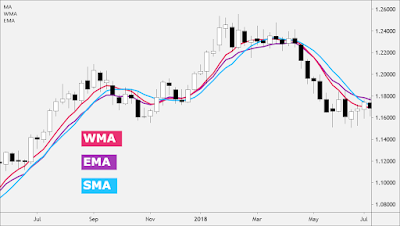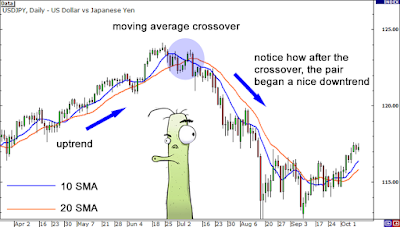Complete Guide to Moving Averages: Trading Strategies, Settings & Best Practices
📌 What is a Moving Average (MA)?
A Moving Average (MA) is a widely used technical indicator that helps traders smooth out price data to identify trends and reversals. It is calculated by averaging a stock’s price over a specific number of periods.
👉 Key Uses of Moving Averages:
Identifying trend direction
Finding support & resistance levels
Generating trading signals
Smoothing out market noise
There are different types of Moving Averages, each with its own calculation method and significance.
📊 Types of Moving Averages & Their Calculation
1️⃣ Simple Moving Average (SMA)
The Simple Moving Average (SMA) is the average price over a specific period. The formula is:
🔹 SMA Formula:
Where:
P = Closing prices of the asset
n = Number of periods
✅ Example: If a stock’s closing prices for the last 5 days are 100, 102, 104, 106, 108, then: SMA (5) = (100+102+104+106+108) / 5 = 104
2️⃣ Exponential Moving Average (EMA)
The Exponential Moving Average (EMA) gives more weight to recent prices, making it more responsive to price changes.
🔹 EMA Formula:
Where K = 2 / (n+1)
✅ Example: EMA(10) assigns 18.18% weight to the latest price, while EMA(50) assigns only 3.92%.
3️⃣ Weighted Moving Average (WMA)
A Weighted Moving Average (WMA) assigns different weights to each data point, with more importance given to recent prices.
🔥 Best Moving Average Trading Strategies
1️⃣ Golden Cross & Death Cross Strategy
Golden Cross: When the 50-day MA crosses above the 200-day MA, it signals a strong uptrend (BUY).
Death Cross: When the 50-day MA crosses below the 200-day MA, it signals a strong downtrend (SELL).
2️⃣ Moving Average Crossover Strategy
Use a short-term MA (e.g., 9 EMA) and a long-term MA (e.g., 21 EMA).
BUY when the short MA crosses above the long MA.
SELL when the short MA crosses below the long MA.
3️⃣ Moving Average as Dynamic Support & Resistance
Stocks tend to bounce off MAs in trending markets.
BUY near a rising MA (e.g., 50 EMA in an uptrend).
SELL near a falling MA (e.g., 50 EMA in a downtrend).
4️⃣ EMA + RSI Combo Strategy
BUY when price is above the 50 EMA & RSI crosses above 50.
SELL when price is below the 50 EMA & RSI crosses below 50.
5️⃣ Triple Moving Average Strategy
Use three different MAs: Short (9 EMA), Medium (21 EMA), and Long (50 EMA).
BUY when the 9 EMA crosses above the 21 EMA and both are above the 50 EMA.
SELL when the 9 EMA crosses below the 21 EMA and both are below the 50 EMA.
6️⃣ Mean Reversion Strategy
Works best in range-bound markets.
BUY when price moves far below a long-term MA (e.g., 200 SMA) and starts reverting.
SELL when price moves far above a long-term MA and starts reverting.
7️⃣ Breakout Strategy with Moving Averages
Combine MAs with breakout levels.
BUY when price breaks above resistance and is above the 50 EMA.
SELL when price breaks below support and is below the 50 EMA.
⏳ Best Timeframes for Moving Averages
📌 Short-Term Traders:
9 EMA, 20 EMA (for Intraday & Scalping)
📌 Swing Traders:
50 SMA, 100 SMA (for medium-term trading)
📌 Long-Term Investors:
200 SMA, 50 SMA (for long-term trend following)
📈 Stocks & Index Trading Using Moving Averages
✅ Best Stocks for Moving Average Strategies:
Large-cap stocks with high liquidity
Trending stocks with strong momentum
✅ Best Indices for Moving Average Strategies:
NIFTY 50, SENSEX, S&P 500, NASDAQ, Dow Jones
🎯 Stop-Loss & Target in Moving Average Trading
✅ Stop-Loss Placement:
Below the moving average in an uptrend (for BUY trades)
Above the moving average in a downtrend (for SELL trades)
✅ Target Placement:
Previous swing highs/lows
1.5x - 2x the risk-reward ratio
🚀 Advanced Moving Average Variants & Techniques
🔹 Hull Moving Average (HMA):
Reduces lag & provides smoother trend signals.
🔹 Adaptive Moving Average (AMA):
Adjusts sensitivity based on volatility.
🔹 Double & Triple Moving Average Strategies:
- Use multiple moving averages to confirm trends.
🔥 Final Thoughts: Should You Use Moving Averages?
✅ Moving Averages are great for identifying trends. ✅ Best when combined with volume, RSI, MACD, and trendlines. ✅ Avoid using MAs in sideways or choppy markets.
💡 Bonus Tip: Moving Averages work best with other indicators like RSI & MACD for confirmation!
📢 Do you use Moving Averages in your trading? Share your thoughts in the comments! 🚀
#MovingAverages #TechnicalAnalysis #StockMarket #TradingIndicators #PriceAction #SwingTrading #DayTrading
.png)

.jpg)
.jpg)









